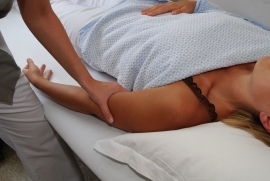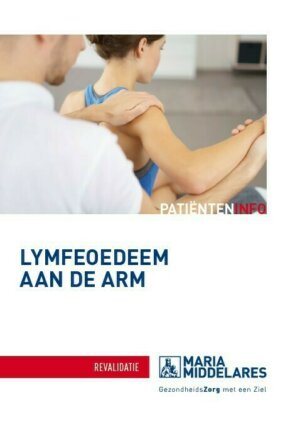Lymphoedema in the arm
Symptoms and causes
Symptoms and causesWhat is it?
Lymphoedema is an abnormal accumulation of protein and fluid in body tissue as a result of an imbalance between the supply and discharge of fluid. This accumulation obstructs the drainage of moisture. This disrupts the transport of lymph fluid to the lymph nodes. Possible symptoms of lymphoedema are: swelling, feeling tired and heaviness, pain, movement restrictions and/or limitations in daily functioning, skin abnormalities and infections. To prevent lymphoedema from developing, a person should try not to create too much lymph fluid in the arm and to keep the lymph fluid flowing well in the arm.
Symptoms
As a result of the surgery, the arm on the side of the surgery may become stiff. Stiffness mainly occurs when an armpit removal has been carried out. You are advised to do exercises with your arm. It is important that you also do the exercises that you were taught in the hospital at home.
The armpit glands have the task of draining lymph fluid. Sometimes the drainage of lymph fluid from the arm can be reduced after an armpit removal. This can also happen later if the armpit has undergone radiation. Extra lymph fluid is created if you do too much heavy work with your arm or if your arm or hand get inflamed. The chance of an annoying swollen arm is 5 to 10%. This means that more than 90% of patients do not have a swollen arm and are able to function normally.
Some patients may experience permanent pain. Even after an armpit gland removal in which the sensory nerves running straight through the armpit sometimes have to be removed, you can experience pain in the armpit in addition to the numb sensation on the inside of the upper arm. Ordinary painkillers often do not help. The symptoms can be experienced as very annoying.
Advice
Advice- If you are lying down or sitting down, put your arm and hand a little higher. Use an extra pillow for this.
- Do not have blood pressure measured on the arm on which surgery was performed.
- Do not allow blood to be drawn from the arm on which surgery was performed.
- Do not have an IV inserted in the arm on which surgery was performed.
- Do not overexert yourself in hot weather, take breaks.
- Raise your arm regularly and stimulate blood circulation by alternately squeezing the fingers closed (a fist) and stretching them back out.
- Do not carry heavy loads.
- Do not receive acupuncture and acupressure.
- Try to prevent wounds. If you have a wound: disinfect it well and put a plaster on it. Tip: make sure you have disinfectant at home.
- Wear gloves for rough chores e.g. gardening, dirty housework...
- Ensure good hygiene and skin care.
- Moisturise the skin regularly to prevent chapping and broken cuticles.
- Make sure your hands and nails are clean.
- Do not scratch open pimples and insect bites.
In case of inflammation, contact your physician.
- Extra moisture is created by high temperatures.
- Avoid excessive sunbathing, tanning and sauna visits.
- Be careful with hot baths.
- Do not use warm pouches, cherry pit pillows, a red lamp or warm wraps on your arm or shoulder.
However, it is very important to keep moving. Anxiously sparing your arm is not beneficial and may also lead to shoulder pain. Make sure that you exercise regularly and that you keep the shoulder mobile. Exercise stimulates the lymphatic vessels so that excess moisture is drained. Above all, the movements must be ‘dynamic’, i.e. muscles relaxation must be alternated with muscle tightening.
- Distribute physical work over the day as much as possible.
- Avoid overburdening the arm by calmly building up the activities and work.
- Take breaks when knitting, doing handicrafts, during computer work... and do occasional arm and shoulder exercises.
- Avoid heavy lifting and intensive sports.
- Find a balance between rest and effort.
- Try not to spare the arm too much: move normally and exercise lightly. However, movement should not lead to fatigue, pain or swelling in the arm, shoulder or hand.
If prescribed by your physician, you can be referred to a physiotherapist who will teach you the appropriate exercises. The intention is to repeat the exercises at home on a regular basis.
Treatment
TreatmentAvoid pressure on the arm and shoulder:
- Wear a well-fitting bra.
- Do not wear tight-fitting clothes, jewellery or sleeve-supporting armbands.
- Do not have blood pressure measured on the arm on which surgery was performed.
Examples of exercises:
- Roll the shoulders forward and backward.
- Raise your shoulders and then drop them again.
- Move the affected arm or both arms forward and up.
- Move the affected arm or both arms up sideways.
- Place both hands in the neck, and move the elbows forward and backward.
- Both hands on the shoulders, turning both elbows forwards and backwards.
- Lift both arms backwards.
Lymphoedema can develop despite all the lifestyle rules. It is not clear why one person devlelops it and another does not. The symptoms that can occur in the arm, armpit, chest or back are:
- swelling (possibly temporary)
- a very tense or tired feeling in the arm
- loss of function or restricted mobility of the arm
- pain and/or tingling in the arm
If you notice these symptoms, you can first try to give the arm rest and put it higher. If the symptoms do not diminish within a few days, please contact your physician. Do not have a powerful, kneading massage be performed on the site of the oedema. You can go to a physiotherapist (specialised in lymphatic drainage) if prescribed by the physician. She will initiate lymphatic drainage combined with exercises of your shoulder, arm and hand.
Lymphatic drainage is a massage technique having the purpose of:
- Improving lymph drainage
- Activating the immune system
- Reducing the pain

You are entitled to 60 physiotherapy sessions a year (F-pathology) in case of lymphoedema after radiotherapy or glandular enlargement. The physiotherapist will request this from the health insurance.
- Initially three to five times a week, then it will be reduced to once a week.
- Manual lymph drainage and adapted exercises.
- Keep doing the exercises at home as much as possible.
- In the case of pronounced lymphoedema, this may not be enough. A specialised examination or volume measurement can demonstrate this. In that case you are eligible for more physiotherapy sessions per year, up to a maximum of 250 in a year. It is best to contact your attending physician for this.
You can always contact the physiotherapy unit for further information and/or treatment.
Leaflet
LeafletYou can find more information in the leaflet at the bottom of the page.
Only available in Dutch:

Lymfeoedeem aan de arm
DownloadLatest publication date: 15/05/2024
Something wrong or unclear on this page? Report it.



